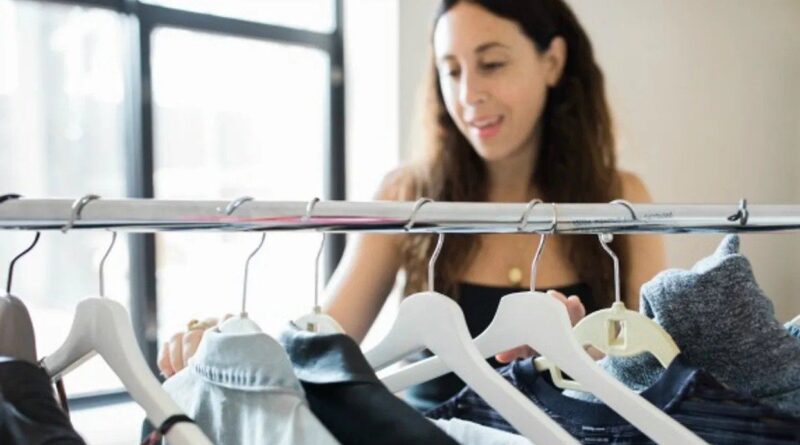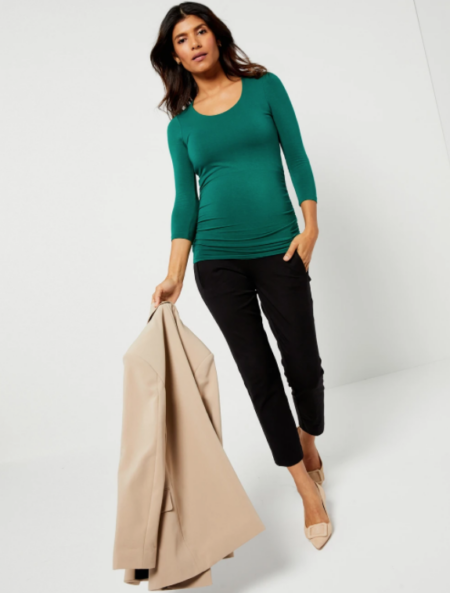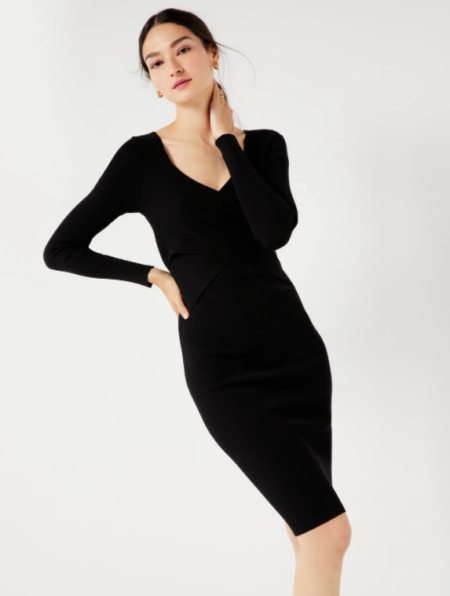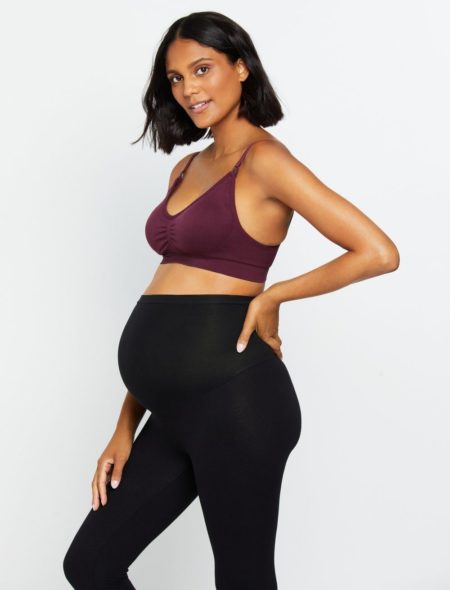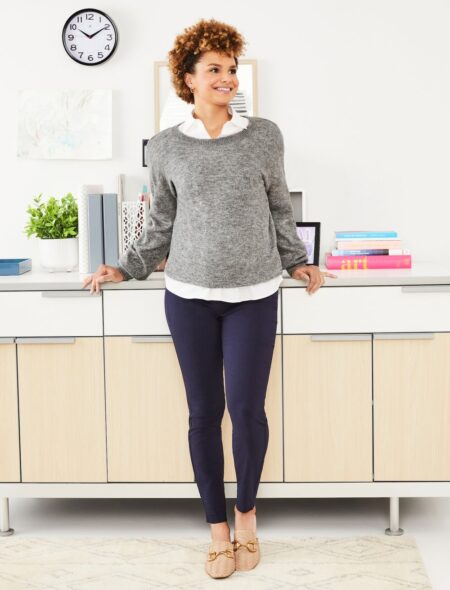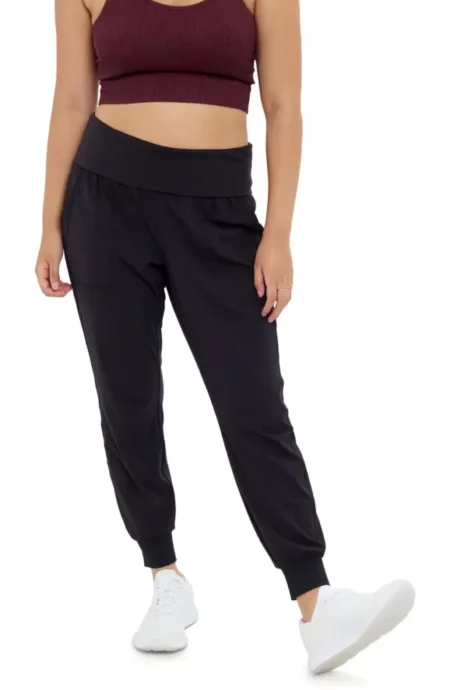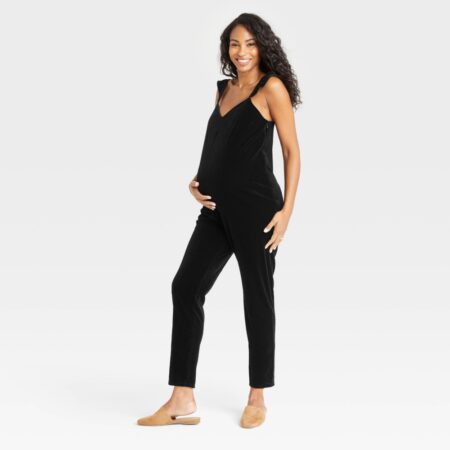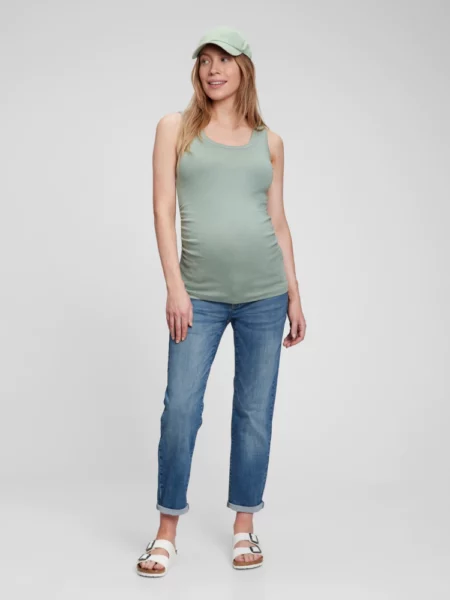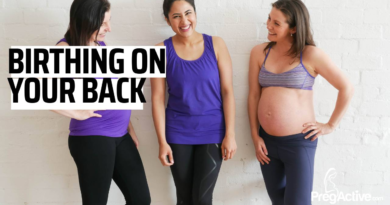How to dress for your first trimester, according to a fashion editor
When it comes buying maternity clothes in the early days of pregnancy, it can be hard to find your personal style, especially if you are still keeping the exciting news under wraps. And while the first trimester comes with a lot of physical changes on the inside, the visible ones (hello, bump!) don’t take shape until you are further along.
So how, exactly, do you dress a bump that’s not quite there yet? The key is to know what exactly to wear during this time to make you feel the most comfortable and beautiful.
Looking for first trimester clothes? Here are our fashion tips to remember during those early days of pregnancy, mama:
1. Opt for affordable maternity styles and items that can you can wear long-term
In the second trimester you’ll have a better idea where your weight will be distributed (other than the belly), so it’s best to hold off on spending loads of money on maternity pieces to ensure this investment takes you through the duration of your pregnancy. Or, if you do find a piece you love and it’s a bit higher priced, ensure that it’s a practical purchase that can be worn into the 2nd and 3rd trimesters. (The best buys are items you can enjoy even after baby arrives!)
2. Embrace your belly
The baby is coming and you may or may not be telling everyone yet. We get it, mama! But you have a long journey ahead when it comes to showing off the bump so why not start embracing it now? The beginning days can appear more bloating than true baby bump so some mamas want to hold off on the form-fitting belly enhancing silhouettes until the second trimester. But, we say go for it!
3. Invest in a very comfy bra
Your breasts will start changing as early as conception—in fact, it may be one of the very first pregnancy symptoms you get. As your breasts grow, it’s a good idea to invest in a few new bras to ensure the fit and support is complimentary to your new shape. Our pick? This style from Motherhood Maternity. It’s soft as butter and will double as a nursing bra later.
4. Prioritize how you feel
We know, leggings are comfortable and easy to wear throughout your entire pregnancy. We love wearing them, too but it’s easy to fall into the legging rut early in the game. As an alternative, consider a pair of classic joggers. Or how about some sleek pants that are just as comfortable but far more polished?
4. Invest in practical, comfortable pieces that work as layers
Your body temperature will likely fluctuate as your hormones seem to shift to all corners of the universe. That means some days you’ll strip down to a tank and shorts. Other days you’ll want nothing more than to wrap up in a cozy sweater with a hot cup of tea. So, adding some layering options like a soft cardigan wrap sweater is a good idea.
5. Treat yourself to something cute and trendy, because you can
Gone are the dated, embarrassing maternity styles of years past. Todays’ pregnant woman gets to look adorable while tooling around town in the trendiest styles, including a roomy jumpsuit.
6. Don’t forget to add a comfortable, practical pair of maternity jeans into your cart
Wear them to work, wear them to run errands, wear them out for date night, or wear them to sit on the couch binge-ing Netflix. Just pick a pair you love and you’ll be all set.
When do I start wearing maternity clothes?
Ah, the great wardrobe switch-up! Entering the world of maternity clothes is like stepping into a new realm of comfort and style, tailored just for you and your growing baby bump. But when exactly is the right time to make the transition? Let’s dive in, mama!
Listening to Your Body
First things first, every pregnancy is unique, just like every body is unique. There’s no one-size-fits-all answer to when you should start wearing maternity clothes. The key is to listen to your body. When your regular clothes start feeling snug and uncomfortable, it might be time to explore maternity options. This could be as early as the first trimester for some, while others might not dip into maternity wear until the second trimester.
First Trimester Tips
In the early days of pregnancy, you might not need full-on maternity clothes just yet. Instead, look for transitional pieces like leggings, tunics, and loose-fitting dresses. These items can accommodate subtle body changes without screaming “maternity.” Also, a belly band can be a lifesaver, allowing you to keep wearing your regular jeans and pants a bit longer by covering unbuttoned waistbands.
Second Trimester Shifts
By the second trimester, you’ll likely start to see more of a baby bump. This is when most women dive into maternity wear. Your body starts to change more noticeably, and comfort becomes a priority. Look for maternity jeans with supportive belly panels, stretchy maternity leggings, and tops that highlight your beautiful growing bump. Remember, maternity clothing sizes generally correspond to your pre-pregnancy sizes, so don’t assume you need to size up dramatically.
Embracing the Bump
The third trimester is when you’re in full-on maternity mode. Embrace it, mama! This is the time to invest in pieces that make you feel fabulous, despite any discomfort. Opt for breathable fabrics, supportive footwear, and dresses that offer ease and comfort. Don’t forget to accessorize with bold jewelry or fun scarves to keep your personal style shining through.
After Baby Arrives
Don’t pack away your maternity clothes too quickly after your baby is born. Your body will need time to adjust post-pregnancy, and many maternity pieces can transition into postpartum wear, especially those designed for nursing. Plus, there’s something to be said for the comfort of those stretchy waistbands during the first few weeks post-birth.
Final Thoughts
The transition into maternity wear is a personal journey. It’s all about what makes you feel comfortable, confident, and beautiful. There’s no “right” time to start wearing maternity clothes—only the right time for you. So, whether you’re swapping out your skinny jeans at 8 weeks or clinging to your regular wardrobe until 18 weeks, it’s all normal. Remember, mama, this is your pregnancy, your body, and your style. Wear what makes you feel good and supports your journey into motherhood. After all, when you’re comfortable and happy, your baby feels it too. Happy dressing!
Frequently Asked Questions
What should I wear in the first trimester of pregnancy?
During the first trimester, opt for comfort and flexibility. Think stretchy leggings, soft tunics, and loose-fitting tops. Your body is just starting to change, so clothes that can adapt are key. Wrap dresses and adjustable waistbands will become your new best friends.
What not to wear when pregnant?
Skip tight belts, restrictive waistbands, or any clothing that puts pressure on your belly. High heels can also become uncomfortable as your pregnancy progresses, so it’s a good idea to stick to flats or supportive sneakers.
What clothes are uncomfortable in early pregnancy?
Tight jeans, fitted blazers, or any rigid, non-stretch clothing can become uncomfortable as your body starts to change. It’s best to avoid these in the early stages of pregnancy and opt for more forgiving, stretchy fabrics instead.
What should I wear at 4 months pregnant?
At 4 months, you might start to notice more of a bump. This is a great time to invest in a couple of maternity basics like a good pair of maternity jeans or a belly band to give your growing bump support. Flowy dresses and layered tops can also offer both style and comfort.
When will my bump start to show?
Every woman is different, but many start to show between 12 to 16 weeks. Don’t worry if you pop a little earlier or later—your body is doing exactly what it needs to for your baby.
When do you start showing in your first pregnancy?
In a first pregnancy, you might start showing a bit later, usually around the end of the first trimester or the beginning of the second trimester. But it’s all normal, so embrace your body’s timeline.
Why is my belly so big at 6 weeks pregnant?
At 6 weeks, bloating is more likely the culprit than an actual baby bump. Hormonal changes can cause significant bloating early in pregnancy, making your belly feel bigger than it actually is.
When should I stop sleeping on my stomach during pregnancy?
It’s best to stop sleeping on your stomach when it starts to feel uncomfortable. For most women, this happens around the second trimester when the belly starts to grow. Sleeping on your side, especially the left side, can increase blood flow and nutrients to your baby.
How does your lower stomach feel in early pregnancy?
In early pregnancy, your lower stomach might feel tender or sensitive. You may also experience bloating or mild cramping as your body adjusts to the changes. These sensations are normal, but if you’re concerned, it’s always best to consult with your healthcare provider.
A version of this story was published November 16, 2021. It has been updated.

